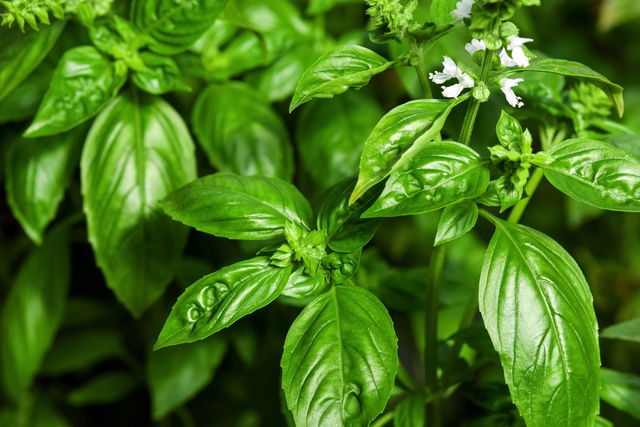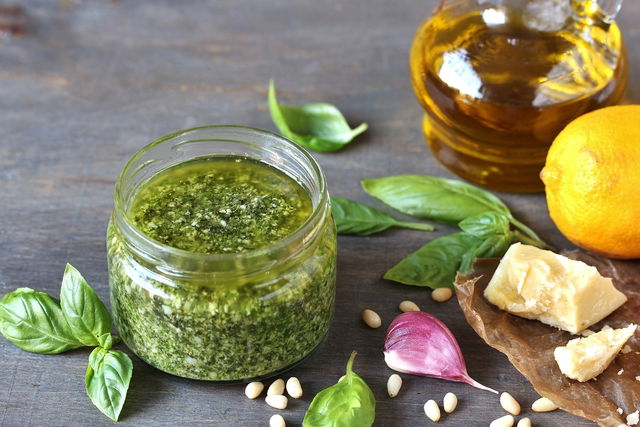Basil is an aromatic herb rich in essential oils such as geraniol, eugenol and linalool. It also boasts excellent amounts of tannins, saponins and flavonoids, which have antispasmodic, digestive, diuretic, sedative and antioxidant properties. These can help to prevent and combat health problems such as colds, high blood pressure, heart attacks or insomnia.
Scientifically referred to as Ocimum basilicum, fresh or dehydrated basil leaves can be purchased at markets, supermarkets, and natural health stores. It can be used in sauces, salads or juices, or used to make teas, baths, dressings or essential oils.

Health benefits
Basil can be used for:
1. Treating cold, flu and bronchitis
Basil has excellent amounts of essential oils and antioxidants that help relax the muscle cells in the lungs. This can help improve and relieve coughs related to colds, flu and bronchitis.
In addition, because it has anti-inflammatory and antimicrobial properties, basil can also relieve lung irritation and help fight the viruses responsible for colds and flu.
2. Improve digestion
Basil is rich in ursolic acid, a compound with antioxidant and anti-inflammatory activity that protects and improves liver function as well as improve digestion.
Because of its anti-spasmodic properties, basil can help to prevent stomach cramps and gastric discomfort. The herb also has carminative properties which can combat excess gas.
3. Prevent and treat high blood pressure
There are high concentrations of eugenol present in basil. It contributes to blood vessel relaxation, preventing and helping to treat high blood pressure.
The antioxidants present in basil, like the tannins, saponins and flavonoids, also prevent the formation of free radicals in the body that can cause damage to the arteries. This can help to prevent and manage high blood pressure.
4. Combat anxiety, depression and insomnia
Basil has great amounts of geraniol and linalool, which are two substances present in basil essential oil. These act on the central nervous system by promoting mental relaxation and improving depression, anxiety and insomnia.
5. Prevent heart attack and atherosclerosis
Basil is rich in antioxidants, such as flavonoids and tannins, which help to lower the levels of "bad" cholesterol in the blood. This can prevent diseases such as heart attack, stroke and atherosclerosis.
6. Treat wounds and insect bites
Basil has antiseptic and antimicrobial properties and can be used to make a healing paste to be applied directly to the skin. It is very effective for treating skin wounds and insect bites.
7. Aid in weight loss
Because it is a powerful diuretic, basil can be used to reduce excess fluid in the body, which can aid in weight loss.
Basil also helps to regulate anxiety related to binge eating, which can help with hunger management and reduce overeating.
8. Relieve migraines
Basil essential oil is rich in menthol, geraniol and linalool, which have relaxing and anesthetic properties that can relieve migraines when inhaled or applied to the skin.
9 . Treat canker sores, sore throat and tonsillitis
Because it has antioxidant, anti-inflammatory and antimicrobial properties, basil can be used in teas, mouthwashes or gargles to treat canker sores, gingivitis, sore throats and tonsillitis.
10. Regulate blood sugar levels
Some studies [1] [2] indicate that basil can help regulate blood sugar, as it stimulates insulin production in the pancreas, inhibits glucose production in the liver and increases glycogen secretion..
Therefore, frequently including basil in your diet can be an excellent option to complement treatment for diabetes or pre-diabetes.
Nutritional info
The following table outlines the nutritional information of 100 g (or 40 tablespoons) of fresh basil:
To obtain all of the benefits of basil, it is important to maintain a healthy, balanced diet and to exercise regularly.
How to consume
The most commonly used parts of basil are the leaves, stems and seeds, which are used as a base for sauces, salads and juices. Other ways to use basil are in the form of teas, as a food seasoning, as an essential oil or as a medicinal ointment.
- Basil tea: place 10 fresh or dried basil leaves in a cup of boiling water. Cover the cup and set aside for 5 to 10 minutes. Strain and drink up to 3 times a day.
- Basil essential oil: add 1 drop of essential oil to another cream and use up to 3 times a day. You can also inhale the oil directly from the bottle for 2 to 3 seconds. Another way to use the oil is to dilute 1 drop of it in 1 tablespoon of vegetable oil, such as jojoba, coconut or avocado oil and massage directly into the skin.
- Basil ointment: Place 2 tablespoons of fresh basil leaves in a bowl and knead well until it forms a paste and apply directly to the wound or insect bite.
Another way to use basil is to soak in it, in a bath. Dilute 18 drops of basil essential oil in 3 tablespoons of milk or vegetable milk and mix it in the bath water. You can soak in the tub for 20 minutes.
Healthy recipes with basil
Basil goes well with dishes made with tomatoes, olive oil, and cheeses. It can be used as a seasoning for omelets, stews, fish, chicken, salads, soups or sauces.
1. Pesto sauce

Ingredients:
- 2 cups of fresh basil tea
- ½ cup of walnut or pine nuts tea
- 100 g of parmesan cheese
- 2 garlic cloves
- 1 and ½ cup extra virgin olive oil
- Salt to taste
How to prepare:
Wash and dry the basil leaves well and set aside. Peel the garlic cloves and place in a food processor or mixer. Add the olive oil, walnuts and parmesan cheese and blend well. Add the basil leaves and blend a little more until you obtain a homogeneous sauce. Season with salt and use on pasta, chicken or as a salad dressing.
2. Basil and mango juice
Ingredients:
- 8 fresh basil leaves
- ¼ mango
- 3 ice cubes
- 100 ml of filtered water
How to prepare:
Wash the mango, then peel it, cut into cubes and place in a blender. Wash the basil leaves and place in a blender. Add the ice cubes, water and mix well. Transfer to a glass and serve.
3. Caprese salad
Ingredients:
- 2 buffalo mozzarellas
- 5 ripe tomatoes
- 3 sprigs of basil
- olive oil to taste
- Salt and black pepper
How to prepare:
Wash and dry the tomatoes and basil leaves well. Cut each tomato into 8 equal parts and set aside. Cut the buffalo mozzarella in half and then each half into 3 wedges. On a platter, place the tomato slices, alternating them with the buffalo mozzarella. Season with olive oil, salt, black pepper, olive oil and finish with basil leaves. Serve with toast, bread or as a side dish to fish or chicken.
